Inventions
Madeleine Ravier’s Bicycle for Animals
Humans have invented mechanical devices, such as bicycles, that allow us to move faster by amplifying the power of our limbs. Madeleine Ravier of Paris argued that what works for people should also work for animals. So she invented and, in 1907, patented a "Cycles pour animaux," or 'bicycle for animals'.Her patent is in French, but the automatic translation is fairly comprehensible. Here's part of it.
Quite recently (less than 50 years ago), understanding the imperfection of his own limbs, he endowed them with mobile mechanisms, he put cycles, devices formed of 2 or 3 wheels between the legs. and of a few light and simple organs, with which he has prodigiously increased the extent of his movements without the help of external energy.
He thus achieved 370 kilometers in 12 hours (cyclist Cadolle), and even 45,764 kilometers (record of cyclist Bouhours), while excellent athletes, on their limbs, did not achieve, at most, at the same time of 12 hours than the already very high distances of 113 kilometers (walker 5o Hibbird) or ikh kilometers (rowell runner)....
What man did for himself he can do it for animals, or at least for some of them; There is a way to increase the efficiency of their limbs by the intercalation, between these limbs and the field of motion, of mechanical devices receiving the reciprocating motion of the limbs, transforming it into continuous rotary motion, and ending in rotating parts; and the result obtained can be used to make animals move man faster and farther than has hitherto been done by using them.
Ravier imagined making bicycles for all kinds of animals including "mules, donkeys, elephants, camels, dromedaries, etc.". But she started with a bicycle for horses, as shown below.
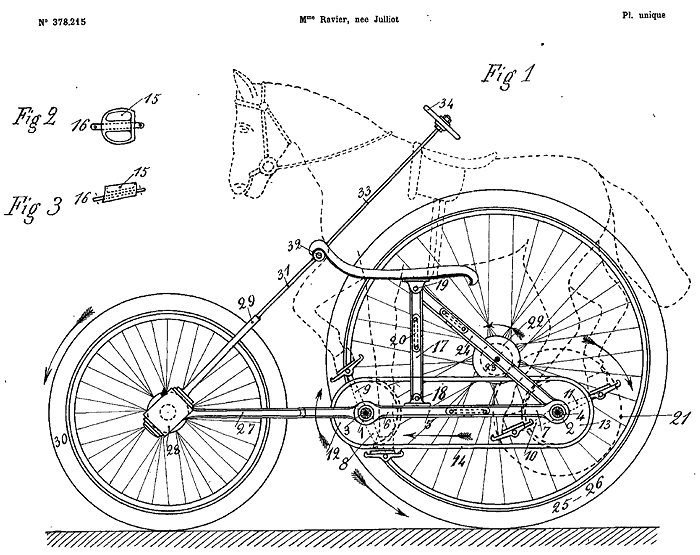
I have no idea if she ever built and tested one of these horse bicycles. The language barrier makes researching this a challenge.
Posted By: Alex - Sun Aug 08, 2021 -
Comments (5)
Category: Animals, Bicycles and Other Human-powered Vehicles, Inventions, Patents, 1900s
Ron Popeil, RIP
His obit at CNN.
Posted By: Paul - Fri Jul 30, 2021 -
Comments (1)
Category: Excess, Overkill, Hyperbole and Too Much Is Not Enough, Inventions, Chindogu, Television, Advertising
Banvard’s Folly
I am halfway thru reading this book and can testify to its greatness, and to its allure for all WU-vies. I have already learned about so many hoaxes, weirdos and charlatans I never knew about before.Here's how the book opens:

Posted By: Paul - Thu Jul 01, 2021 -
Comments (8)
Category: Frauds, Cons and Scams, History, Historical Figure, Hoaxes and Imposters and Imitators, Inventions, New Age, Supernatural, Occult, Paranormal, Books, Goofs and Screw-ups
Polyform, Edison’s Topical Anesthetic
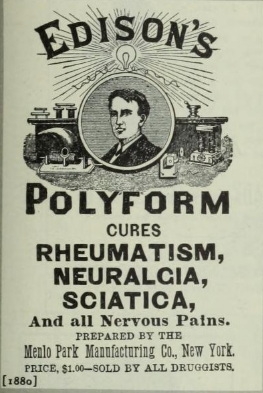
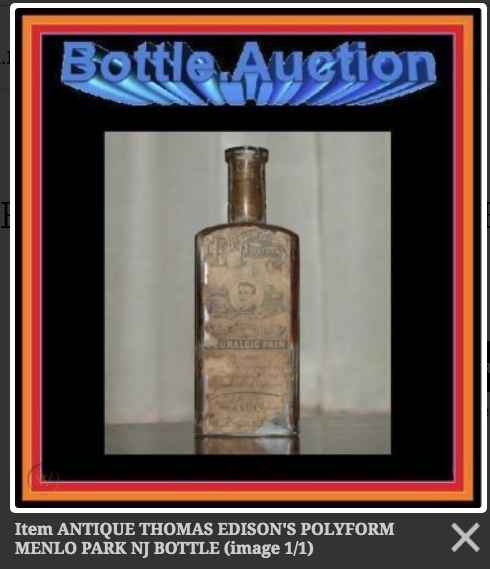
American inventor and businessman Thomas Alva Edison is legendary for his contributions to such technologies as the lightbulb, the telephone, the phonograph, and motion pictures, among many others.1In his lifetime, Edison obtained 1,093 US patents and some 1,239 patents in other countries. Little known among these efforts was his “improved anesthetic compound.”
In the summer of 1882, George F. Shrady (Founder and Editor, Medical Record 1866–1904) (1837–1907), reported that Thomas Edison invented a new anesthetic made of chloroform, ether, alcohol, and camphor and had applied for British and German patents.2The witty but misinformed editor added, “Edison may wish to use it on his stockholders until electric light was in successful operation.”
In fact, the “anesthetic” actually was an analgesic liniment that Edison had prepared in early 1878. He named it Polyform and advertised it for “neurologic pain.” Polyform was a mixture of chloroform, ether, camphor gum, alcohol, chloral hydrate, morphine, and oils of peppermint and clove. Edison believed that his compound’s various analgesics would potentiate each other and that the mixture would attack pain in a “shotgun manner.”3
More info here.
Posted By: Paul - Thu Jun 24, 2021 -
Comments (1)
Category: Celebrities, Inventions, Patent Medicines, Nostrums and Snake Oil, Nineteenth Century
Horse Spike
In 1899, Patent No. 636,430 was granted to Franz and Konrad Hieke of Philadelphia for what they described as "cavalry equipment". It was essentially a large spike attached to the front of a horse. From their patent:
A better view:

Argos Reflector - Feb 8, 1900
I wonder if one of these was ever actually used in combat?
Posted By: Alex - Tue Jun 22, 2021 -
Comments (3)
Category: Animals, Inventions, Patents, Weapons, Nineteenth Century
Atomic Survival Jacket
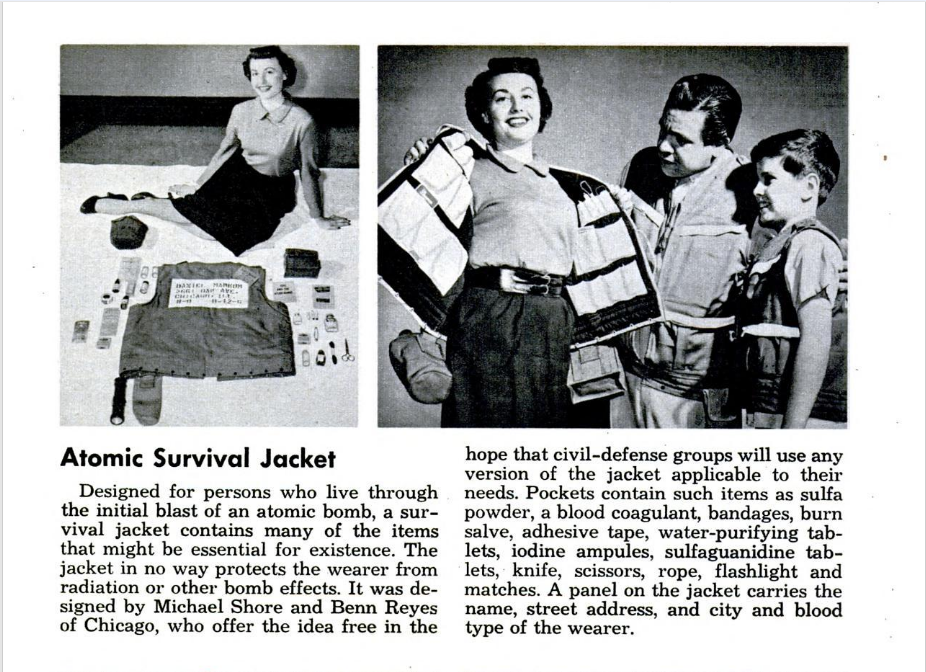
Source
Posted By: Paul - Thu Jun 17, 2021 -
Comments (4)
Category: Death, Inventions, War, Atomic Power and Other Nuclear Matters, 1950s
Staying awake at the wheel
Over the years, inventors have dreamed up a variety of ways to keep drivers awake while driving.In 1936, Carl Brown got a patent on a chin-operated alarm device. If a driver started to nod off, and his head fell forward, this would depress a trigger, setting off an electric bell that would wake him up. (Patent No. 2,066,092)

In 1940, Raymond Young had the idea that whenever a driver was feeling drowsy he could press a button on the steering wheel and this would squirt an aromatic spray in his face, waking him up. (Patent No. 2,199,060)
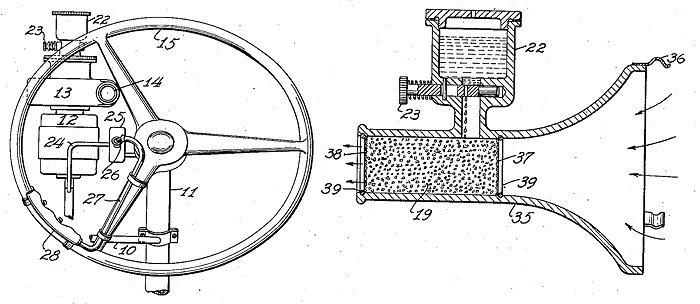
And just last month, Hyundai was granted a patent for a system that shoots ultrasonic beams at a driver's eyes when it senses he's falling asleep. (Patent No. 11007932)

Posted By: Alex - Mon Jun 14, 2021 -
Comments (3)
Category: Inventions, Patents, Sleep and Dreams, Cars
The Airphibian
Flying cars just had a recent moment in THE NEW YORK TIMES. But there have been many predecessors.We are continuing our streak from yesterday's Amphicar: bi-modal transport!
The Wikipedia page.
Posted By: Paul - Mon Jun 14, 2021 -
Comments (0)
Category: Inventions, Kludges, Hacks and Duct-tape Repairs, Air Travel and Airlines, 1940s, Cars
The 1964 Amphicar
We've featured various amphibious vehicles on WU before. But my research seems to indicate we have not highlighted the most famous, seen in this video. Please note that inventor Hans Trippel was working on this concept thirty years previously, as seen in the clipping.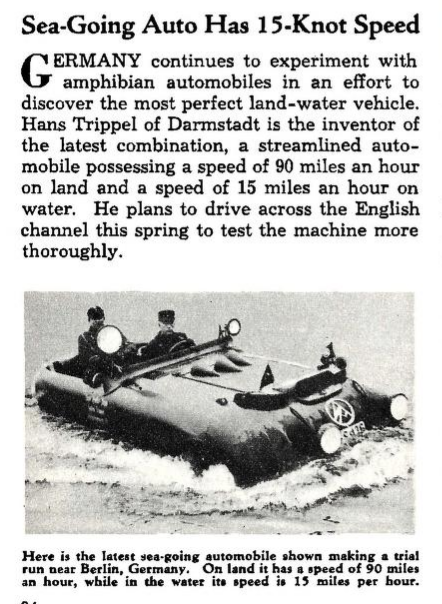
Source.
Posted By: Paul - Sun Jun 13, 2021 -
Comments (4)
Category: Inventions, Oceans and Maritime Pursuits, 1930s, 1960s, Cars
The Safety Smoker
The "safety smoker," invented by Glen R. Foote of Cincinnati, promised to allow people to safely smoke "in places where the danger from flying or falling sparks is likely to start a conflagration or cause an explosion."Perfect for anyone hankering for a smoke in an oil refinery.
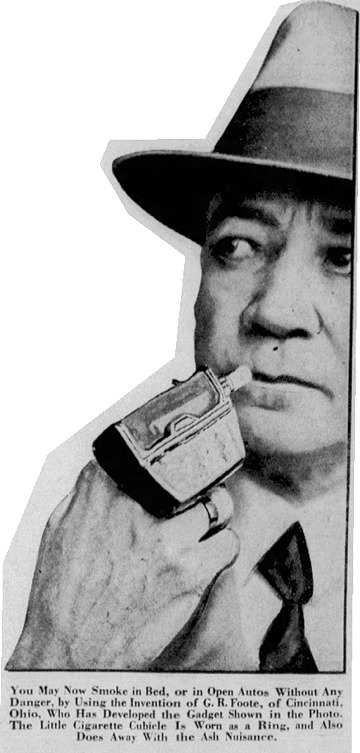

San Francisco Examiner - Jan 1, 1933
Posted By: Alex - Mon Jun 07, 2021 -
Comments (6)
Category: Inventions, Smoking and Tobacco, 1930s

| Who We Are |
|---|
| Alex Boese Alex is the creator and curator of the Museum of Hoaxes. He's also the author of various weird, non-fiction, science-themed books such as Elephants on Acid and Psychedelic Apes. Paul Di Filippo Paul has been paid to put weird ideas into fictional form for over thirty years, in his career as a noted science fiction writer. He has recently begun blogging on many curious topics with three fellow writers at The Inferior 4+1. Contact Us |




